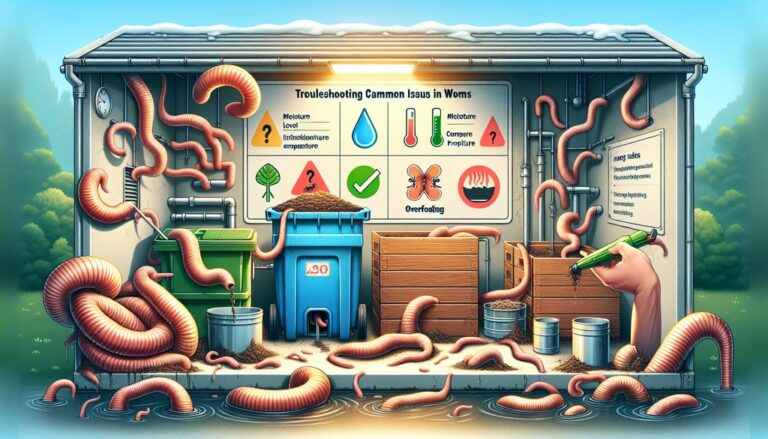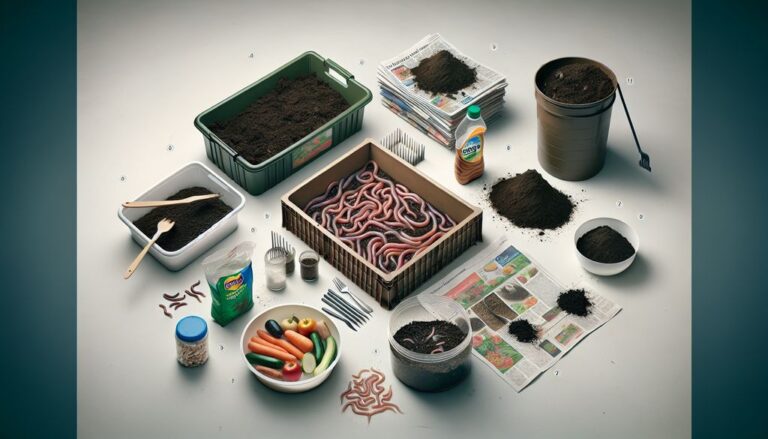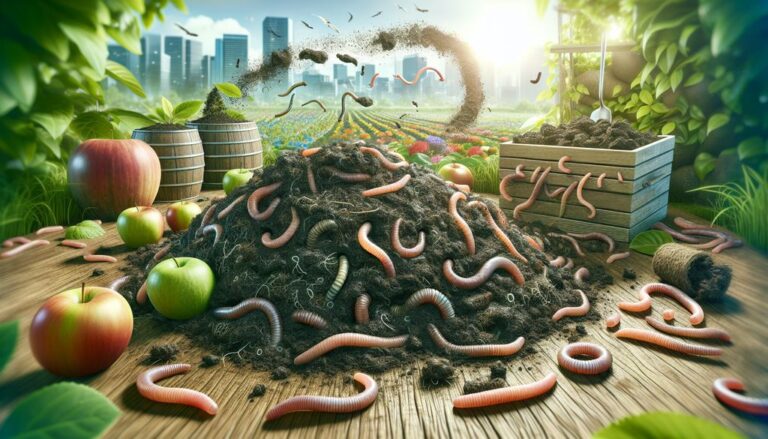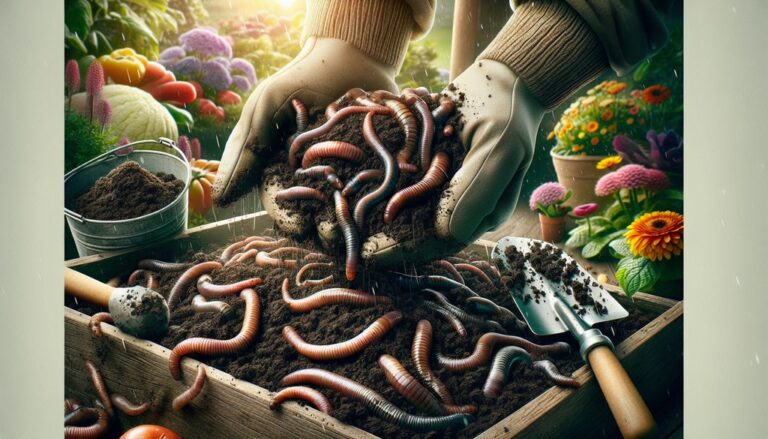Maximizing the efficiency of a worm bin involves a combination of environmental optimization, nutrition enhancement, and population management. By implementing advanced techniques, worm bin owners can achieve higher productivity and healthier worm populations. In this article, we will explore key strategies for maximizing worm bin efficiency and reaping the benefits of vermicomposting.
Key Takeaways
- Maintain ideal temperature for optimal worm activity
- Balance moisture levels to prevent dryness or saturation
- Ensure proper airflow to promote aerobic decomposition
- Select nutrient-rich foods to support worm health and reproduction
- Balance carbon and nitrogen sources for effective composting
Optimizing Worm Bin Environment
Maintaining Ideal Temperature
To maximize the efficiency of your worm bin, it’s crucial to maintain an ideal temperature range. Worms thrive best between 55°F and 77°F (13°C and 25°C), which allows them to digest food waste more effectively and reproduce optimally. Outside of this range, worms can become stressed or inactive, slowing down the composting process.
- Below 55°F (13°C): Worms become sluggish and may eventually go dormant.
- Above 77°F (25°C): Worms can overheat and die.
To keep your worm bin within this ideal temperature range, consider the following tips:
- Place the bin in a location that avoids extreme temperatures, such as a shaded area during summer or an insulated garage in winter.
- Use a thermometer to regularly check the bin’s temperature.
- Add insulating materials like shredded newspaper or cardboard to help regulate temperature.
By consistently monitoring and adjusting the conditions of your worm bin, you can ensure a healthy and productive environment for your worms.
Balancing Moisture Levels
Achieving the right moisture level in your worm bin is crucial for the health and productivity of your worms. Too much moisture can lead to odors and anaerobic conditions, while too little can cause the worms to dehydrate and die. Aim for the consistency of a wrung-out sponge, which is about 80% moisture. Here’s how you can maintain this balance:
- Monitor moisture regularly by feeling the bedding; it should be moist to the touch but not dripping water.
- Add dry bedding such as shredded newspaper or cardboard if the bin is too wet.
- Sprinkle water over the bedding if it feels too dry, ensuring even distribution.
Maintaining the right moisture level is not just about adding water or dry materials; it’s about creating an environment where worms can thrive and efficiently break down organic matter.
Remember, the moisture level can also be influenced by the type of food scraps you add. Foods with high water content, like melons and cucumbers, will release moisture as they decompose. Balance these with drier materials to keep the moisture levels in check.
Creating Proper Airflow
Ensuring your worm bin has proper airflow is crucial for the health and efficiency of your composting system. Adequate ventilation helps control moisture, odors, and regulates the temperature within the bin. It also provides the necessary oxygen that worms require to thrive and process organic material effectively.
- Drill holes around the sides and bottom of your bin to promote air circulation.
- Regularly turn the compost to introduce fresh air and prevent compaction.
- Use a bulking agent like shredded cardboard to keep the bedding aerated.
Maintaining a balance between air and moisture is key to avoiding an overly wet or dry environment, which can be detrimental to your worms.
Remember, too much airflow can dry out the bin, while too little can lead to anaerobic conditions, which are harmful to worms. Monitor your bin and adjust as needed to maintain the ideal environment for your composting worms.
Enhancing Worm Bin Nutrition
Selecting Nutrient-Rich Foods
To maximize the efficiency of your worm bin, it’s crucial to provide your worms with a diet that’s rich in nutrients. Worms thrive on a mixture of fruit and vegetable scraps, coffee grounds, and eggshells. These items not only offer a balanced diet but also promote a healthy bin environment.
- Fruit and vegetable scraps should be the staple of the worm diet.
- Coffee grounds can be added in moderation to provide grit and stimulate digestion.
- Crushed eggshells help to maintain the bin’s pH balance and provide necessary calcium.
It’s important to avoid overfeeding and to introduce new foods gradually to prevent acidity and other issues that can harm your worms.
Remember, the goal is to create a sustainable ecosystem within your worm bin. By carefully selecting the right foods, you can ensure that your worms remain healthy and productive, leading to a more efficient composting process.
Balancing Carbon and Nitrogen Sources
Achieving the right balance between carbon and nitrogen in your worm bin is crucial for efficient composting. Carbon-rich materials, often referred to as ‘browns’, provide energy for the worms, while nitrogen-rich materials, known as ‘greens’, supply protein and growth nutrients.
- Browns include items like shredded paper, cardboard, dry leaves, and straw.
- Greens consist of kitchen scraps, coffee grounds, and fresh plant material.
A common ratio recommended for worm bins is 25-30 parts carbon to 1 part nitrogen. However, this can vary based on the specific materials used and the conditions within your bin.
Maintaining this balance is not just about the numbers; it’s about observing your worms and adjusting based on their behavior and the condition of the compost.
If the bin is too wet or smells unpleasant, it may indicate an excess of nitrogen. Conversely, a bin that’s too dry or slow to compost might need more nitrogen. Regular monitoring and adjustments will help you find the perfect balance for your worm bin ecosystem.
Managing Worm Bin Population
Controlling Overpopulation
Controlling the population within your worm bin is crucial for maintaining a healthy ecosystem. Overpopulation can lead to insufficient resources, stress, and even the death of worms. To manage the number of worms, consider the following steps:
- Regularly monitor the worm population and bin conditions.
- Harvest worms when the bin becomes crowded.
- Donate or sell excess worms to other gardeners or composters.
- Adjust feeding rates to control reproduction.
By keeping the population in check, you ensure that each worm has enough space and resources to thrive, which in turn maximizes the efficiency of your worm bin.
Remember, a balanced worm bin is a productive one. If you notice signs of overpopulation, such as a decrease in compost quality or worms trying to escape, it’s time to take action. Reducing the number of worms will help restore balance and maintain the overall health of your composting system.
Encouraging Reproduction
To maintain a thriving worm bin, encouraging reproduction is essential. Worms reproduce more when they are comfortable and well-fed. A balanced diet rich in organic matter is key to promoting worm fertility. Here are some steps to encourage worm reproduction:
- Provide a variety of food sources, including fruit and vegetable scraps, coffee grounds, and eggshells.
- Maintain the bin at a pH level between 6.5 and 7, which is ideal for worm reproduction.
- Keep the bin’s environment dark and undisturbed, as worms prefer these conditions for mating and cocoon laying.
By creating an environment that mimics the worms’ natural habitat, you can boost their reproduction rates and, consequently, the efficiency of your worm bin.
Remember, a healthy worm population is indicative of a well-maintained bin. Monitor your worms regularly to ensure they are reproducing and adjust your bin conditions as needed. With the right care, your worm bin can be a sustainable source of rich compost for your garden.
Conclusion
In conclusion, maximizing worm bin efficiency requires a combination of advanced techniques and careful management. By implementing the strategies discussed in this article, you can significantly improve the productivity and effectiveness of your worm bin. Remember to monitor the conditions, provide proper maintenance, and adjust the techniques as needed to ensure the best results. With dedication and attention to detail, you can create a highly efficient and sustainable worm composting system that benefits both your garden and the environment.
Frequently Asked Questions
What is the ideal temperature for a worm bin?
The ideal temperature for a worm bin is between 55°F and 77°F (13°C and 25°C). Temperatures outside of this range can stress the worms and affect their efficiency.
How do I balance moisture levels in a worm bin?
To balance moisture levels, add dry bedding materials like shredded paper or cardboard to absorb excess moisture, or add small amounts of water to moisten dry bedding.
What are some nutrient-rich foods for worm bins?
Nutrient-rich foods for worm bins include fruit and vegetable scraps, coffee grounds, eggshells, and small amounts of grains and bread. Avoid feeding dairy, meat, and oily foods.
Why is it important to balance carbon and nitrogen sources in a worm bin?
Balancing carbon (brown) and nitrogen (green) sources ensures that the worms receive a well-rounded diet and helps prevent odors and imbalances in the bin.
How can I control overpopulation in a worm bin?
To control overpopulation, harvest mature worms for use in the garden or share them with other worm bin enthusiasts. You can also adjust feeding to slow down reproduction.
What can I do to encourage reproduction in a worm bin?
To encourage reproduction, provide a suitable environment with proper food, moisture, and temperature. Avoid disturbing the bin excessively, as this can disrupt the worms’ reproductive process.






